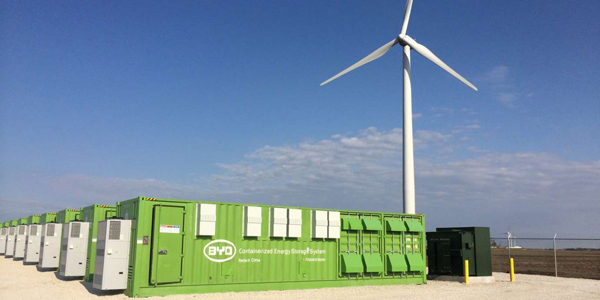MISO’s shift to renewable resources can be supported by energy storage devices — but only to a small degree, the RTO said Tuesday.
The final results from MISO’s Renewable Integration Impact Assessment (RIIA) show that transmission is still key to economically using an expanding renewable fleet, though strategically placed energy storage can help.
“Storage, without adequate transmission capacity in the system, may help increase renewable energy delivery but may not sufficiently aid in meeting renewable penetration targets,” MISO Manager of Policy Studies Jordan Bakke told stakeholders during a special teleconference.
After running the RIIA with storage considerations, MISO found that transmission — not energy storage — remains most effective at delivering a hypothetical 40% renewable share of the resource mix under four study scenarios. However, the RTO said transmission buildout with select storage additions seems to be the most effective way to meet renewable energy goals and “may achieve the best overall value.”
Previous results from the RIIA have excluded the role of energy storage expansion, which some stakeholders say is a key consideration in the transition to a primarily renewable generation fleet.
MISO has previously said it can likely operate its system reliably with renewable penetration targets up to 50%, but only if its members engage in dramatic transmission expansion. (See MISO Renewable Study Shows More Tx, Tech Needed.) MISO currently operates with about 8% renewables.
“What we found with wind [and] solar generation, the complexity or challenges that that grid faces increases exponentially beyond 30% [penetration]. … Existing infrastructure becomes inadequate for fully accessing the diverse resources across the MISO footprint. What you need is to change how the grid operates,” Bakke said.
MISO Senior Policy Studies Planner Chen-Hao Tsai said storage alone cannot unlock delivery of a hypothetical 96 GW of renewables every hour of the year.
“Beyond 30%, we still need some substantial transmission solutions,” Tsai said, adding the transmission need remains the strongest to deliver wind generation from the northern portion of the footprint to load centers.
But MISO said an “optimum” amount of storage can help flatten its load curve and spread out an increasingly narrow loss-of-load risk.
The RTO previously found that as renewable generation grows, its daily loss-of-load risk compresses into a steeper and shorter period later in the evening. (See MISO Renewable Study Predicts Later Peak, Narrower LOLE Risk.)
“It will help move that availability around,” Bakke said. Storage resources can concentrate charge and discharge times depending on whether reliability risk is high or low, he said, but they are only available for so long, especially batteries.
When MISO offered both transmission and storage as solution candidates in its study simulation, its algorithm chose to build only a modest 0.5 GW of battery storage. When it ordered its algorithm to only select storage solutions to access the 40% renewable energy mix and not transmission, the simulation added 16 GW of storage footprint-wide at a cost of billions of dollars.
Stakeholders seemed taken aback that MISO’s optimal simulation would recommend such a small amount of storage.
Bakke said the study focused narrowly on how storage can aid renewable energy delivery and adequacy across all operating hours of the year.
“Much of the storage being added now is for planned power plant optimization. It has little to nothing to do with the grid,” Bakke said. “A lot of the planned hybrids today are around plant optimization, not grid optimization.” Storage is also being built to provide ancillary services, something else the renewable integration study did not cover, he said.
Bakke said the storage phase of the RIIA only sought “general truths” about its role in enabling renewable growth and was not designed to favor transmission buildout.
“There is a saturation point after which incremental storage isn’t helpful anymore and the effective load-carrying capability of renewables doesn’t increase,” MISO Policy Studies Senior Engineer Nihal Mohan said. “The results somewhat surprised us. … If we keep on adding more and more storage on the system, we start to see a decline of ELCC on the system.”
Mohan said CAISO has documented a similar trend of diminishing returns of storage after a certain point.
MISO also found that storage devices are more helpful when they are placed next to renewable generation, not load centers.
“When you co-locate storage at generation, it’s kind of like you’re putting a little reservoir near your generation. If you pair storage near the load — if you do not try to solve the transmission issue — there is still renewable curtailment,” Tsai said.
The results are the final leg of the yearslong RIIA. Bakke said MISO’s next order of business on the study is to summarize all study findings into a comprehensive report for stakeholders. He said the report should be completed by the first quarter of 2021.




